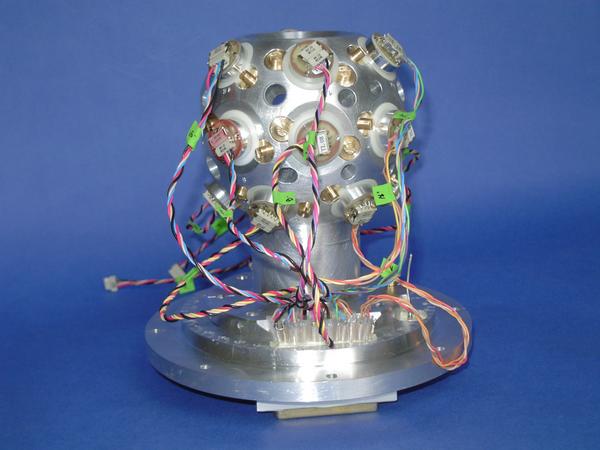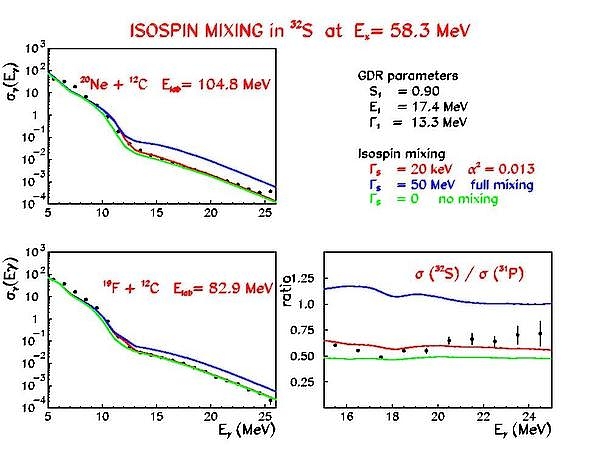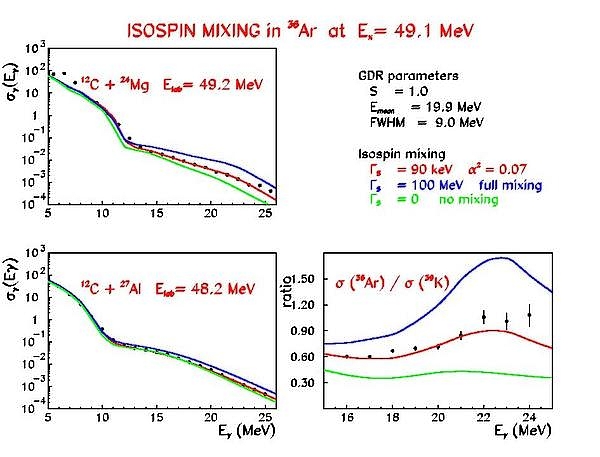

















Other experimental set-ups: IGISOL CUDAC CUP Si Detectors BARRIERS SYRENA ICARE EAGLE Giant Dipole Resonance GroupInstitute of Exp. Physics, Warsaw University Maciej Kisieliński, Jarosław Choiński - HIL, Warsaw University Wiesław Czarnacki - SINS, Świerk Contact: Marta Kicińska-Habior, Marta.Kicinska-Habior(at)fuw.edu.pl We are studing emission of high-energy γ-rays (Eγ=5-50 MeV) and presently also light-charged particles (Ep,α=5-50 MeV), which occurs in heavy-ion collisions at projectile energy of Eproj=4-10 MeV/u. In the last few years our studies performed at HIL have been devoted to two topics. Firstly, we studied heavy-ion collisions at projectile energy around 5 MeV/u, where complete fusion is the main mechanism of the reaction, and the statistical decay of the produced compound nucleus is the main source of the emitted γ-rays and charged particles. In order to study the Giant Dipole Resonance (GDR) in highly excited 70,76Se and later on in 32S and 36Ar nuclei, we have examined the 12C + 58,64Ni at 4 MeV/u , 20Ne+12C at 5.2 MeV/u, and 12C + 24Mg reaction at 4 MeV/u, where the γ-ray and particle emission is expected to be mostly of the statistical character. During the recent years significant progress has been achieved in the experimental and theoretical studies of the GDR built on highly excited states of compound nuclear systems and it has been proved that the γ-decay of the GDR is an important tool for learning about the properties of hot nuclei. The method is based on the fact that in the compound nucleus formed in heavy-ion fusion reaction the GDR is excited and then decays with emission of a high-energy photon. Since the GDR is built on highly excited state and it may couple to the quadrupole degrees of freedom of the nucleus, the γ-rays from its decay carry information about the shape of the hot nucleus. We have made an attempt to study the shape of the 70,76Se highly excited nuclei. In the GDR studies of N=Z compound nuclei the isospin mixing may be determined from comparison of the measured high-energy γ-ray spectrum with statistical model calculations. When the N=Z compound nuclei are populated by entrance channel with the isospin T=0, the γ-ray yield from the decay of the GDR built on excited states depends on the isospin of the final states, and the purity of isospin population of the initial state. In particular, the E1 decays from T=0 to T=0 states are isospin forbidden because of the isovector nature of the electric dipole radiation. The transitions from T=0 to T=1 states are allowed, but there are not many T=1 final states available to be populated by the GDR decays. This causes an inhibition of the γ-decay of N=Z compound nuclei formed in a T=0 entrance channel. Thus, in the absence of isospin mixing, the yield of high-energy γ-rays in the statistical decay of self-conjugate nuclei populated by entrance channels with the isospin T=0 is due to GDR γ-decays of the compound nucleus populating T=1 final states, and γ-decays in daughter nuclei formed by particle emission. This yield is suppressed by a factor of 2-3 in comparison with the yield from the isospin-allowed decay of neighboring compound nuclei with N=/=Z at similar excitation energy. The yield of high-energy γ-rays in γ decay of N=Z compound nuclei increases in the presence of isospin mixing. It was originally proposed by Mushin Harakeh et al. [1] to use this effect to determine the degree of isospin mixing in N=Z compound nuclei, 28Si and 24Mg. Similar method was used to determine the degree of isospin mixing in 28Si and 26Al [2]. We have made an attempt to determine the isospin mixing probability in the 32S and 36Ar compound nuclei at excitation energy around 50 MeV using Warsaw Cyclotron beams. Secondly, in our experiments at HIL we also study heavy-ion collisions at projectile energy above 6 MeV/u. Recent results of the analysis of the 18O + 100Mo [3] and 12C + 58,64Ni reactions [4] have shown that in order to extract correct Giant Dipole Resonance parameters from high-energy γ-ray emission studies in heavy-ion collisions at projectile energies above 6 MeV/u, all processes occurring in the collision, i.e. complete and incomplete fusion, preequilibrium nucleon emission and bremsstrahlung γ-ray emission have to be included. In order to reliably measure the excitation energy, mass and charge of the decaying nucleus produced in the collision, the light emitted particles should be measured and analyzed together with high-energy γ-rays. In accordance with this, we have started a modification of the multidetector JANOSIK set-up [5,6], which now allows measurement of energy spectra and angular distributions of light charged particles by sixteen Si telescopes placed in the vacuum chamber around the target. Each telescope consists of a 10 μm thick superthin ΔE detector, 130 μm thick ΔE detector, and a 11 mm thick E detector. We have used the particle detector system in the new project devoted to the γ-ray (Eγ=5-50 MeV) and light-charged particle (Ep,α=5-50 MeV) emission studies in the 20Ne + 12C heavy-ion collisions at projectile energies of Eproj/A=5-10 MeV/u. The purpose of this work is to determine contributions of different processes in the mechanism of the studied reactions at several projectile energies within a discussed range, and to investigate the properties of hot, fast rotating compound nuclei produced in these reactions, as a function of the effective nuclear temperature [12,14]. Experimental set-up at the Warsaw CyclotronDuring last years the multidetector system JANOSIK [5,6] (Fig.1) was built at the Warsaw Cyclotron and began providing experimental results [7-14]. High-energy γ-rays emitted in reactions studied are detected in a 25 cm x 29 cm NaI(Tl) crystal which is surrounded by an active plastic shield 10 cm thick made by BICRON, a passive 6LiH shield and a low activity 10 cm thick lead shield. The cosmic rejection efficiency obtained with those shields is not worse than 98 %. The entire spectrometer assembly is supported by a carriage which can be rotated around the target axis running on the bent, nearly semicircular track. The detector can also be moved radially by a screw arrangement in the 60 cm to 120 cm range of distance from the target to the crystal face. The angular range with the system positioned at a distance of 80 cm is 40o to 140o with respect to the beam axis. In order to control the NaI(Tl) gain stability a blue LED pulser is used. The multiplicity of low-energy γ-rays is measured by the multiplicity filter, which consists of 32 small scintillator detectors (12 BaF2 and 20 NaI(Tl)) surrounding the target chamber. The efficiency for 1.17 MeV γ-ray from a 60Co source is around 10 %. The n-γ discrimination achieved by the standard time of flight technique, with the time resolution of 4.5 ns at a 83 cm distance between the crystal face and the target, allows a very good separation of the events induced by γ-rays produced in the target and by neutrons.
Because of the planned measurement of light-charged particles: protons and alphas (Ep,α=5-50 MeV) JANOSIK set-up was additionally supplied with a set of 16 silicon telescopes.
Figure 2: Si-ball set-up consisting of twelve triple telescopes in the angular range of 39o-140o, each consisting of a 10 μm thick superthin ΔE detector, 130 μm thick ΔE detector and a 11 mm thick E detector. Recent results obtained at the Warsaw Cyclotron beamIn order to extract the isospin mixing probability in the 32S compound nuclei, the γ-ray spectra from the statistical decay of the GDR built on excited states in 32S and 31P compound nuclei have been measured, analyzed and compared with statistical model calculations [9,10]. The 32S and31P compound nuclei were formed with similar excitation energies of 58.3 MeV and 55.1 MeV by reactions 20Ne + 12C (with isospin T=0) and 19F + 12C (with isospin T=/=0). The experiments were analyzed in terms of Coulomb spreading width Γ>↓, which determines the mixing of the T states into T< states at given excitation energy. On the basis of sum rules and experimental suggestions it is expected that the Coulomb spreading width should not change much with the excitation energy and the mass of the nucleus. Thus we used the same Γ>↓ for 32S and 31P, as well as for the daughter nuclei at a given excitation energy. In order to increase the sensitivity to the isospin mixing we have analyzed the ratios of γ-ray cross-sections for the reactions forming 32S (N=Z) and 31P (N=/=Z) nuclei for the measured and calculated yields. Calculations for several values of isospin mixing parameters: α<2=0 (no mixing), α<2=0.013 and α<2= 0.5 (full mixing) are shown in Fig. 3. As it can be seen, the best reproduction of the ratio of the experimental data is obtained at α<2=0.013 +/-0.015 [10]. Similarly, we have extracted the value of the isospin mixing probability α<2=0.07+/-0.03 for 36Ar nuclei at excitation energy around 50 MeV [11,13],[Fig. 4].
Figure 3: Spectra of γ-rays emitted during the decay of 32S (upper-left) and 31P (bottom-left) and the ratios of these spectra (bottom-right). The curves - CASCADE fit with different isospin mixing spreading width: Γ>↓=0 - no mixing (lowest curve), Γ>↓=20 keV (middle curve) and Γ>↓=50 MeV-full mixing (upper curve) [10].
Figure: 4 Spectra of γ-rays emitted during the decay of 36Ar (upper-left) and 39K (bottom-left) and the ratios of these spectra (bottom-right). The curves - CASCADE fit with different isospin mixing spreading width: Γ>↓=0 - no mixing (lowest curve), Γ>↓=90 keV (middle curve) and Γ>↓=100 MeV-full mixing (upper curve) [11,13]. In order to determine the contributions of different processes in the mechanism of the studied reaction 20Ne + 12C at 9.5 MeV/u we have measured the spectra of γ-rays (Eγ=5-50 MeV) and light-charged particles (Ep,α=5-50 MeV) at different angles. The particle spectra have been measured in coincidence with high-energy photons. High-energy γ-ray spectra for this reaction have been also measured: the inclusive one and the exclusive one in coincidence with charged-particles. In both spectra the high-energy tail corresponding to the bremsstrahlung γ-ray emission can be seen. The inclusive spectrum have been fitted by using CASIBRFIT code and assuming that in the reaction studied at projectile energy around 9 MeV/u all the processes mentioned earlier occur. The analysis is in progress [12,14]. These works were partly supported by the Polish State Committee for Scientific Research (KBN Grants No. 2 P302 071 07 and No. 2 P03B 030 22). Bibliography
|






